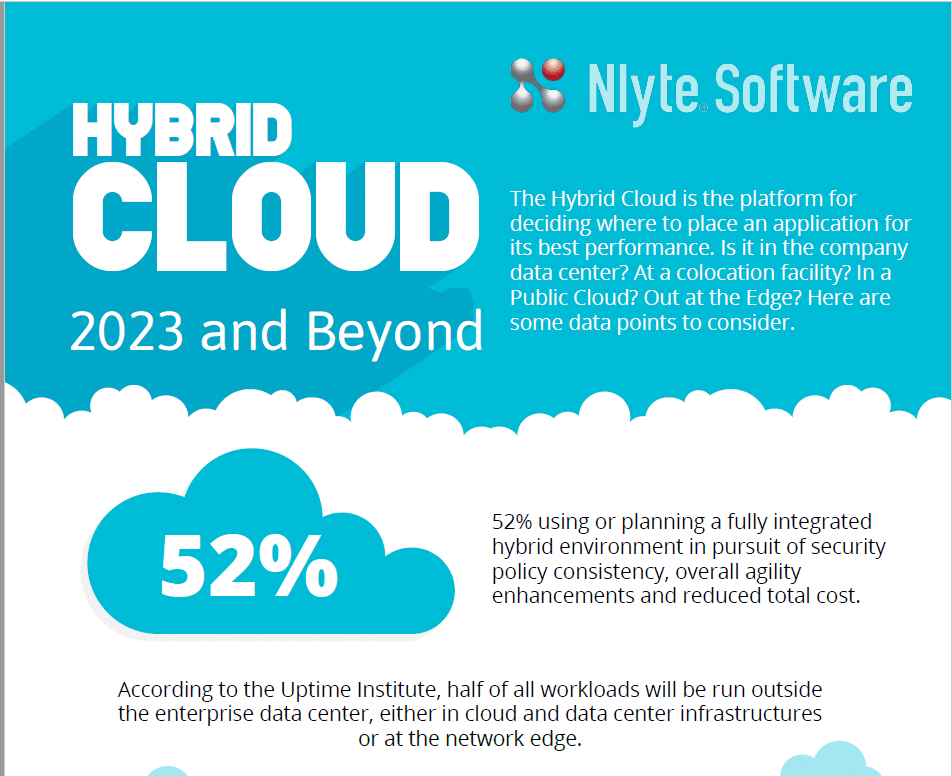Infographic: Hybrid cloud
Published on April 3, 2023,
by
Hybrid Cloud Strategy Insights from Nlyte
Developing a successful hybrid cloud strategy requires careful planning, clear objectives, and the right tools to manage complexity across environments. Nlyte’s infographic outlines the essential questions organizations must ask to align cloud deployments with business goals, ensure compliance, and optimize performance across public and private infrastructures.
As more organizations adopt hybrid cloud models, the need for a structured approach becomes increasingly important. A hybrid cloud combines on-premises infrastructure with public and private cloud services, offering flexibility, scalability, and cost-efficiency. However, without a clear strategy, this complexity can lead to inefficiencies, security risks, and increased operational overhead.
Nlyte’s hybrid cloud infographic encourages IT leaders to begin with a clear understanding of their business objectives. What are you hoping to achieve—cost savings, improved agility, better disaster recovery, or enhanced scalability? These goals will shape decisions about which workloads belong in the public cloud, which should remain on-premises, and which can benefit from a hybrid approach.
Security and compliance are also central to any hybrid cloud strategy. Organizations must evaluate their regulatory requirements and determine how to maintain data integrity and privacy across multiple environments. This includes implementing consistent governance policies, encryption standards, and access controls.
Another key consideration is data management. In a hybrid cloud, data may reside in multiple locations, making it essential to have policies that ensure consistency, accuracy, and availability. Nlyte recommends evaluating how data will be synchronized, backed up, and accessed across platforms.
Managing the complexity of hybrid environments also requires robust monitoring and automation tools. From networking and storage to application deployment, IT teams need visibility and control to ensure seamless integration and performance. Nlyte’s solutions extend traditional Data Center Infrastructure Management (DCIM) capabilities into the hybrid cloud, offering centralized oversight and intelligent automation.
Cost is another critical factor. A hybrid cloud strategy must account for infrastructure, licensing, maintenance, and potential hidden costs. Organizations should regularly assess their cloud usage and optimize resource allocation to avoid overspending.
Finally, success in hybrid cloud adoption depends on having the right skills and expertise. IT teams must be trained to manage hybrid environments, or organizations must consider partnerships that bring in the necessary knowledge. Measuring success through KPIs—such as uptime, cost savings, and user satisfaction—will help refine the strategy over time.
In summary, a well-executed hybrid cloud strategy enables organizations to balance flexibility with control, optimize performance, and future-proof their IT infrastructure. Nlyte’s infographic serves as a valuable starting point for organizations looking to navigate the complexities of hybrid cloud adoption with confidence.
→ DOWNLOAD the Hybrid Cloud Infographic

Additional posts on this topic
Hybrid Cloud Computing Solutions
Nlyte’s approach to taming the Hybrid Cloud extends the reach of classic Data Center Infrastructure Management across the entire compute infrastructure.
Introduction to the Hybrid Cloud
Learn how a hybrid cloud computing environment uses a mix of on-premises, private cloud and third-party, public cloud services aligning between the two platforms.
The Birth of DCIM: The Evolution from Data Center to Hybrid Cloud
Integrate your networked infrastructure, aggregate and contextualize it as well as address the need to prepare and manage the Hybrid Cloud.
Multi-Cloud vs. Hybrid Cloud: What's the Difference?
What's the difference between a multi-cloud vs. hybrid cloud? Learn how to manage a multifaceted infrastructure with HDIM.
